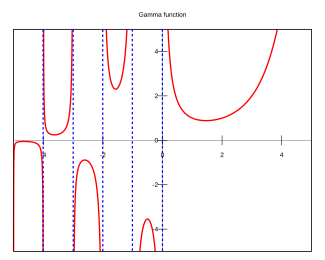Gamma function

In mathematics, the gamma function (Γ(z)) is a key topic in the field of special functions. Γ(z) is an extension of the factorial function to all complex numbers except negative integers. For positive integers, it is defined as [1][2]
The gamma function is defined for all complex numbers, but it is not defined for negative integers and zero. For a complex number whose real part is a positive integer, the function is defined by:[2][3]
Properties
[change | change source]Particular values
[change | change source]Some particular values of the gamma function are:
Pi function
[change | change source]Gauss introduced the Pi function. This is another way of denoting the gamma function. In terms of the gamma function, the Pi function is
so that
for every non-negative integer n.
Applications
[change | change source]Analytic number theory
[change | change source]The gamma function is used to study the Riemann zeta function. A property of the Riemann zeta function is its functional equation:
Bernhard Riemann found a relation between these two functions. This was published in his 1859 paper "Über die Anzahl der Primzahlen unter einer gegebenen Grösse" ("On the Number of Prime Numbers less than a Given Quantity")
Related pages
[change | change source]Notes
[change | change source]- ↑ "List of Probability and Statistics Symbols". Math Vault. 2020-04-26. Retrieved 2020-10-05.
- ↑ 2.0 2.1 Weisstein, Eric W. "Gamma Function". mathworld.wolfram.com. Retrieved 2020-10-05.
- ↑ "gamma function | Properties, Examples, & Equation". Encyclopedia Britannica. Retrieved 2020-10-05.
References
[change | change source]- Milton Abramowitz and Irene A. Stegun, eds. Handbook of Mathematical Functions with Formulas, Graphs, and Mathematical Tables. New York: Dover, 1972. (See Chapter 6)
- Andrews, George E.; Askey, Richard; Roy, Ranjan (2000). Special Functions. Cambridge University Press. ISBN 978-0-521-78988-2.
- Emil Artin, "The Gamma Function", in Rosen, Michael (ed.) Exposition by Emil Artin: a selection; History of Mathematics 30. Providence, RI: American Mathematical Society (2006).
- Birkhoff, George D. (1913). "Note on the gamma function". Bull. Amer. Math. Soc. 20 (1): 1–10. doi:10.1090/S0002-9904-1913-02429-7. MR 1559418. S2CID 120440543.
- P. E. Böhmer, ´´Differenzengleichungen und bestimmte Integrale´´, Köhler Verlag, Leipzig, 1939.
- Bonnar, James (2010). The Gamma Function. Createspace Independent Publishing. ISBN 978-1-4636-9429-6.
- Philip J. Davis, "Leonhard Euler's Integral: A Historical Profile of the Gamma Function," American Mathematical Monthly 66, 849-869 (1959)
- Press, WH; Teukolsky, SA; Vetterling, WT; Flannery, BP (2007), "Section 6.1. Gamma Function", Numerical Recipes: The Art of Scientific Computing (3rd ed.), New York: Cambridge University Press, ISBN 978-0-521-88068-8, archived from the original on 2021-10-27, retrieved 2013-02-10
- O. R. Rocktaeschel, ´´Methoden zur Berechnung der Gammafunktion für komplexes Argument``, University of Dresden, Dresden, 1922.
- Temme, Nico M. (1996). Special Functions: An Introduction to the Classical Functions of Mathematical Physics. John Wiley & Sons. ISBN 978-0-471-11313-3.
- Whittaker, E.T.; Watson, G.N. (1996). A Course of Modern Analysis. Cambridge University Press. ISBN 978-0-521-58807-2.